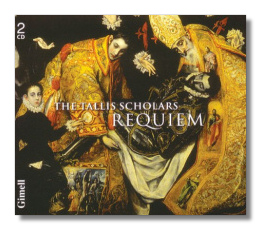
The Internet's Premier Classical Music Source
Related Links
- Latest Reviews
- More Reviews
-
By Composer
-
Collections
DVD & Blu-ray
Books
Concert Reviews
Articles/Interviews
Software
Audio
Search Amazon
Recommended Links
Site News
 CD Review
CD Review
Requiem

- Tomás Luis de Victoria:
- Requiem
- Versa est in luctum
- Duarte Lôbo: Requiem for 6 voices
- Frei Manuel Cardoso:
- Requiem
- Non mortui
- Sitivit anima mea
- Mulier quae erat
- Nos autem gloriari
- Alonso Lôbo:
- Versa est in luctum
- Credo quod redemptor
- Vivo ego, dicit Dominus
- Ave Maria
The Tallis Scholars/Peter Phillips
Gimell CDGIM205 2CDs 154:56
Summary for the Busy Executive: Music to view an El Greco by.
It's the cover of the CD that put the painter in mind: a section of "Burial of Count Orgaz." The CD repackages at least one former release by the Tallis Scholars, to my mind the finest group performing the "hard" sacred music of the Renaissance. The program consists of funeral settings by Portuguese composers and by the Spaniard Victoria.
Renaissance sacred music tends to sound the same, as far as the general idiom goes. The influence of the one holy and apostolic church, both as an intellectual force and as a source of employment, tended toward this kind of homogenization. Indeed, church councils took a great deal of interest in the course of liturgical music and had the economic clout to enforce their decrees. This doesn't mean sports don't appear, but more of them show up in secular music. Furthermore, then as now, many great musicians traveled a good deal, lured by lucrative employment in various European courts. The great Flemish masters - Ockeghem, Obrecht, Josquin, and a host of others - found themselves gainfully employed in France and Italy. Lassus, another Fleming, worked throughout the Holy Roman Empire and indeed may have logged the most miles. Various styles, once considered "national," melded together in this way, foreigners influencing locals and vice versa, although the secular music kept pretty much to its local roots.
The only Portuguese music I had any longstanding familiarity with, the brief motet "Crux fidelis" by King John IV, came off as little more than charming, in a naïve sort of way (like Henry VIII's music), and didn't move me to seek out more. The music here thus counts as a revelation. As far as quality goes, it has nothing to apologize for. These composers keep company with the best of their time. Duarte Lôbo's music, a little later than Victoria's, seems to move from the pure modality of the Renaissance toward the stilo antico of the early Baroque, without ever quite arriving there. One can hear, for example, the occasional bona fide modulation, and furthermore a modulation for emotional effect. Cardoso's Requiem shows traces of Italian Mannerism, twisting modality pretty close to the breaking point. But these phenomena may not appear to anyone other than knowledgeable fans. I don't believe the music will disappoint general listeners, but they may think I 'm raving over nits vs. nats. Beautiful as these things are, they definitely belong to their time, and appreciation may very well depend on experience with other musical contemporaries.
The Victoria, however, transcends its time. I first knew this work from an old EMI LP with the Nederlands Kammerkoor led by Felix de Nobel, close to fifty years ago. The very beginning just about raptured me out, and it has lost none of its power. For most music of this period, we have pretty much lost the emotional key. Music changed radically from Monteverdi on. We can barely tell "happy" or "sad," let alone feel a musical psyche as subtle and complex as Mahler, which tends to estrange us from composers as far away as Ockeghem and Josquin. Victoria, like Monteverdi and Byrd, has what I would call a dramatic sensibility: he deals in strong contrasts of lights and darks, based on the meaning of his texts. The opening measures, after the "Requiem aeternam" plainchant, open up into a vision of a sun-filled eternal rest, an "eternal sunshine of the spotless mind." We miss this penchant for drama in Josquin and Palestrina, for example, as well as in Duarte and the two Lôbos. It's that sensibility that gives us a way in without having to read up on the aesthetics of Renaissance music. I don't say this to denigrate the others; I merely note a difference in the way the music operates.
For those of us used to concert requiems - Mozart, Berlioz, Verdi, Fauré, Duruflé, Britten, for instance - we should also note a difference in function, particularly as the reception of these works has evolved over time. All these later composers express inner feeling. Their works stand as personal testaments on death and Christian doctrine, or at least on Christian imagery. Renaissance composers, on the other hand, operate under a somewhat different aesthetic. In the first place, their requiems premièred with the corpse in the room. To a great extent, they provide a musical backdrop to church ritual, with the abstraction, generalization, and distance that implies. That they indeed produce individually distinguishable works testifies to their mastery.
As I say, I know of no better group for this material than Peter Phillips and his Tallis Scholars. The sound is gorgeous without turgidity, so in tune that it excites you. Most important, Phillips gives these long works shape. The composers themselves provide no help at all. They give you only notes. Many of these requiem movements and motets run six to ten minutes. Whatever expressive structure they have, Phillips has built. I've heard experts beat Phillips up for these very things: the sound is too good; the shaping too intrusive. The goal seems to be a spurious authenticity. After years of living with the authentic but dead, I must say I prefer Phillips.
The engineering is superb as well.
Copyright © 2006, Steve Schwartz




















